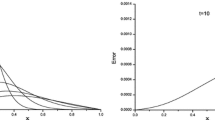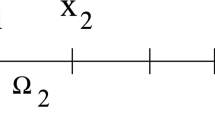Abstract
A least-squares spectral collocation method for the one-dimensional inviscid Burgers equation is proposed. This model problem shows the stability and high accuracy of these schemes for nonlinear hyperbolic scalar equations. Here we make use of a least-squares spectral approach which was already used in an earlier paper for discontinuous and singular perturbation problems (Heinrichs, J. Comput. Appl. Math. 157:329–345, 2003). The domain is decomposed in subintervals where continuity is enforced at the interfaces. Equal order polynomials are used on all subdomains. For the spectral collocation scheme Chebyshev polynomials are employed which allow the efficient implementation with Fast Fourier Transforms (FFTs). The collocation conditions and the interface conditions lead to an overdetermined system which can be efficiently solved by least-squares. The solution technique will only involve symmetric positive definite linear systems. The scheme exhibits exponential convergence where the exact solution is smooth. In parts of the domain where the solution contains discontinuities (shocks) the spectral solution displays a Gibbs-like behavior. Here this is overcome by some suitable exponential filtering at each time level. Here we observe that by over-collocation the results remain stable also for increasing filter parameters and also without filtering. Furthermore by an adaptive grid refinement we were able to locate the precise position of the discontinuity. Numerical simulations confirm the high accuracy of our spectral least-squares scheme.
Similar content being viewed by others
References
Canuto, C., Hussaini, M.Y., Quarteroni, A., Zang, T.A.: Spectral Methods in Fluid Dynamics. Springer Series in Computational Physics. Springer, Berlin Heidelberg New York (1989)
De Maerschalck, B., Gerritsma, M.I.: The use of Chebyshev polynomials in the space-time least-squares spectral element method. Numer. Algorithms 38, 173–196 (2005)
De Maerschalck, B., Gerritsma, M.I.: Higher-order Gauss–Lobatto integration for non-linear hyperbolic equations. J. Sci. Comput. 27(1–3), 201–214 (2006)
Eisen, H., Heinrichs, W.: A new method of stabilization for singular perturbation problems with spectral methods. SIAM J. Numer. Anal. 29, 107–122 (1992)
Gelb, A., Tadmor, E.: Enhanced spectral viscosity approximations for conservation laws. Appl. Numer. Math. 33, 3–21 (2000)
Gerritsma, M.I., Phillips, T.N.: Discontinuous spectral element approximation for the velocity-pressure-stress formulation of the Stokes problem. Int. J. Numer. Methods Eng. 43, 1401–1419 (1998)
Gerritsma, M.I., Proot, M.J.: Analysis of a discontinuous least-squares spectral element method. J. Sci. Comput. 17, 297–306 (2002)
Gottlieb, D., Orszag, S.A.: Numerical analysis of spectral methods: theory and applications. In: CBMS-NSF Regional Conference Series in Applied Mathematics No. 26. SIAM, Philadelphia (1977)
Gottlieb, D., Shu, C.W.: On the Gibbs phenomenon and its resolution. SIAM Rev. 39, 644–668 (1997)
Heinrichs, W.: Least-squares spectral collocation for discontinuous and singular perturbation problems. J. Comput. Appl. Math. 157, 329–345 (2003)
Heinrichs, W.: Least-squares spectral collocation for the Navier–Stokes equations. J. Sci. Comput. 21(1), 81–90 (2004)
Heinrichs, W.: An adaptive least-squares spectral collocation method with triangular elements for the incompressible Navier–Stokes equations. J. Eng. Math. (2007) (to appear)
Henderson, R.D.: Adaptive spectral element methods for turbulence and transition. In: Barth, T.J., Deconinck, H. (eds.) High Order Methods for Computational Physics, pp. 225–324. Springer, Berlin Heidelberg New York (1999)
Jiang, B.-N.: A least-squares finite element method for incompressible Navier–Stokes problems. Int. J. Numer. Methods Fluids 14, 843–859 (1992)
Jiang, B.-N.: On the least-squares method. Comput. Methods Appl. Mech. Eng. 152, 239–257 (1998)
Jiang, B.-N., Chang, C.L.: Least-squares finite elements for the Stokes problem. Comput. Methods Appl. Mech. Eng. 78, 297–311 (1990)
Jiang, B.-N., Povinelli, L.: Least-squares finite element method for fluid dynamics. Comput. Methods Appl. Mech. Eng. 81, 13–37 (1990)
Laney, C.B.: Computational Gasdynamics. Cambridge University Press, Cambridge (1998)
Orszag, S.A.: Spectral methods for problems in complex geometries. J. Comput. Phys. 37, 70–92 (1980)
Peyret, R.: Spectral methods for incompressible viscous flow. In: Applied Mathematical Sciences, vol. 148. Springer, Berlin Heidelberg New York (2001)
Proot, M.J.: The least-squares spectral element method. Ph.D. thesis, Delft University of Technology (2003)
Proot, M.J., Gerritsma, M.I.: A least-squares spectral element formulation for the Stokes problem. J. Sci. Comput. 17, 285–296 (2002)
Proot, M.J., Gerritsma, M.I.: Least-squares spectral elements applied to the Stokes problem. J. Comput. Phys. 181, 454–477 (2002)
Proot, M.J., Gerritsma, M.I..: Application of the least-squares spectral element method using Chebyshev polynomials to solve the incompressible Navier–Stokes equations. Numer. Algorithms 38, 155–172 (2005)
Vandeven, H.: Family of spectral filters for discontinuous problems. J. Sci. Comput. 6, 159–192 (1991)
Author information
Authors and Affiliations
Corresponding author
Rights and permissions
About this article
Cite this article
Heinrichs, W. An adaptive spectral least-squares scheme for the Burgers equation. Numer Algor 44, 1–10 (2007). https://doi.org/10.1007/s11075-007-9071-9
Received:
Accepted:
Published:
Issue Date:
DOI: https://doi.org/10.1007/s11075-007-9071-9




